A good friend will make you laugh, defend you in an argument, cheer you on when you’re doing well and cheer you up when you’re feeling sad. Best buds can be good for your health, too. Maintaining close relationships means less stress and a longer life.
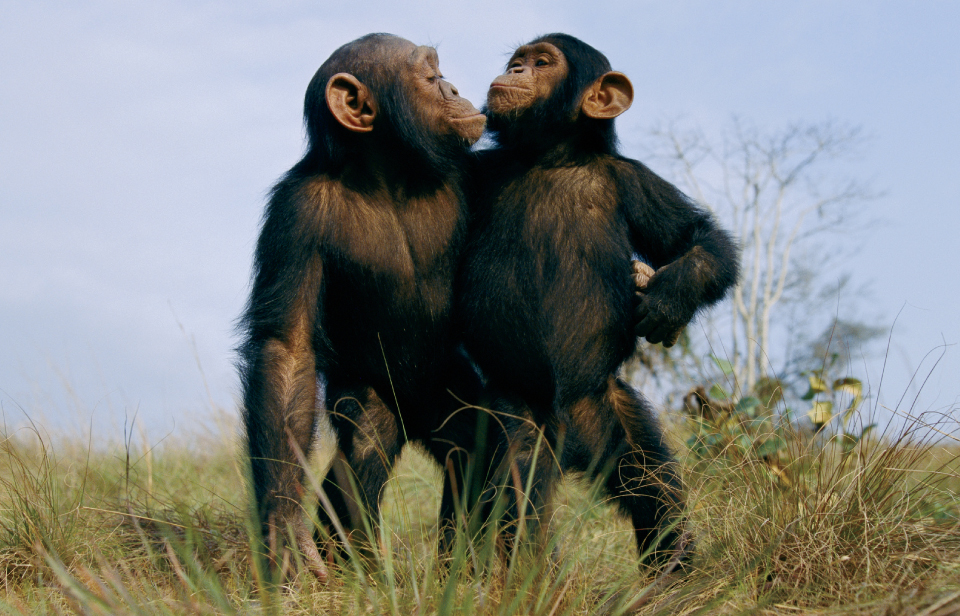
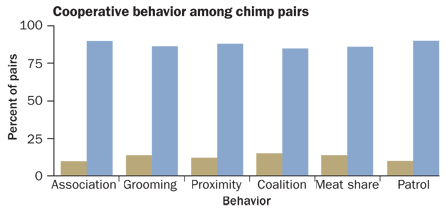
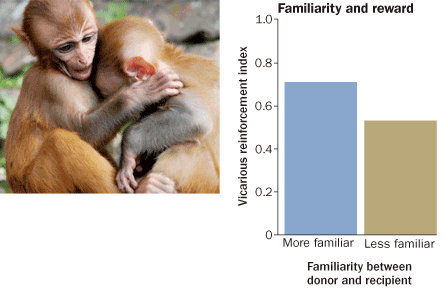
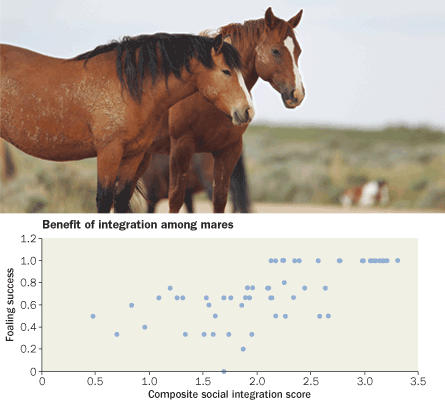
And you don’t even have to be human.
Just as with people, animals of other sorts can benefit from having a BFF. New studies show that animals with someone they can count on — to get them out of a scrape, share food or deliver a kind gesture — are more likely to reproduce and are better at fighting disease.
Such findings suggest that the need for a trusted, dependable companion goes way back in time. If so, friendship may confer evolutionary advantages.
“It’s beginning to look like a strong, evolutionarily ancient phenomenon that’s shared by many social species,” says Dorothy Cheney, a biologist at the University of Pennsylvania in Philadelphia who has studied primate relationships for four decades.
Many of the behaviors that hint at animal friendships have been observed in the field. Studies of monkeys, horses and chimpanzees reveal that individuals are selective about whom they spend time with or feed near. Some male chimpanzees are more likely to hang out together, groom each other, share meat and accompany one another on hunts or border patrols. Female baboons will groom some peers more than others, and are more likely to come to the aid of someone who recently groomed them.
Further studies find that female baboons closely bonded to a few other females have more surviving offspring and often live longer. Similar results have been found in elephants, dolphins and rodents, as well as in horses and chimps.
With these friendly findings in mind, researchers are working to tie together animals’ behavior and physiological responses over time in hopes of better understanding the benefits of having a buddy. Recent work shows, for example, that a social-bonding hormone makes monkeys more generous with others. Other studies are turning to genes to try to understand why some animals win out when it comes to popularity.
Finding all the factors that promote friendship might ultimately provide clues to the origin and evolution of traits that have allowed humans to form close social ties, scientists say.
“These animals know so much about each other’s relationships, and it’s conceivable that this type of social cognition is very important in being able to establish and maintain bonds,” Cheney says. “Which would suggest that there is real evolutionary advantage to, in a sense, being a social wire and being highly motivated to know about each other.”
Got your back
Scientists have long known that animals form bonds. Primates and horses that spend more time in close proximity will generally be friendlier and less aggressive with each other. Chimps and elephants share food, comfort the injured and appear to grieve at the deaths of peers.
Still, for decades the prevailing view was that most interactions occur between closely related individuals. Bonds formed between unrelated animals were supposedly only transient, designed to gain some immediate benefit. Scientists now know that isn’t true. Studies of dolphins, horses, lions and chimpanzees show that even unrelated animals often form stable bonds lasting for years. And evidence indicates that one animal may do something costly to help a nonrelative, while receiving a benefit later.
Such exchanges, known as contingent cooperation, operate daily in human relationships, says biologist Liza Moscovice of Binghamton University in New York. “You might buy coffee for your coworkers, but you expect that at some point they’re going to buy coffee for you too,” she says.
Though it remains unclear whether nonhuman animals keep track of all the favors they give and receive, experiments suggest that contingent cooperation plays a big role in their relationships. In 2010, Moscovice and Cheney, along with others, showed that a shared positive experience can increase the odds that one individual will help the other at another time.
Among the female baboons studied, the primary way of bonding is through grooming. Grooming entails sitting with another and methodically cleaning her fur, a task that provides an immediate benefit to the animal being groomed. “It’s like getting a hug,” Moscovice says.
Grooming has an up-front cost in terms of the time taken away from foraging or resting. But donors might be able to rely on a grooming partner for support if caught in the middle of a fight soon after the exchange, previous studies have shown. Moscovice says having an extra ally or two can be a huge benefit in baboon society, where dominance hierarchies produce inequalities in access to food and resources, and threats and tiffs break out frequently.
Friendship is especially beneficial for animals without relatives to help them out. Among baboons, the strongest social bonds are found between mothers and daughters, followed by sisters and other female relatives, including aunts, nieces and cousins.
In strictly evolutionary terms, relatives cooperate because it promotes survival of their shared genetic material. That genetic link may explain why when screaming for help, a female baboon can rely on her family members for support.
“Relatives generally help regardless of whether they’ve groomed or interacted recently,” Moscovice says. “In this case, it’s not contingent cooperation because relatives basically help across the board.”
To see if good deeds are reciprocated among nonrelatives, even after a considerable amount of time has elapsed, Moscovice and her colleagues set up an experiment. The scientists recorded the vocalizations, or grunts, of female baboons, often delivered to challenge another individual and to recruit aid. After collecting a library of grunts from many individuals, the researchers waited until two unrelated females had groomed and then separated. The team then played the groomer’s “help” call to the other baboon and recorded her response. A control experiment, using the same recordings and same groups of animals, played a female’s “help” call to the other female following an aggressive exchange. The scientists also tested a small number of relatives to compare the outcomes.
The findings, published in 2010 in the Proceedings of the National Academy of Sciences, showed that females who had recently received grooming from a nonrelative almost always moved toward the speaker, as if to seek out the grooming partner in need of help. Help calls played after an aggressive encounter did not elicit such interest.
In contrast, relatives’ decisions about helping each other did not relate to the recent encounters. The findings suggest that female baboons take into account past interactions when choosing to support an unrelated individual.
Moscovice says it makes sense that the evolution of friendship might be based on contingent exchanges of aid, while this would not be necessary for the evolution of cooperation among relatives.
Similar observations have been made in chimps, where an unrelated bystander will step up and support another, if the chimp in need of help is a friend. John Mitani, a behavioral ecologist who has been observing chimpanzees in Uganda’s Kibale National Park since the mid-1990s, says his studies show general patterns in who sides with whom.
“When male chimps form coalitions, they take sides, but they don’t do so randomly,” says Mitani, of the University of Michigan in Ann Arbor. “They take sides with individuals who will later turn around and help them.”
Such alliances are formed around the idea “you scratch my back and I’ll scratch yours,” rather than kinship, he says. In 2009, Mitani showed that 22 of 28 male chimps in a single group formed their longest, closest bond with an unrelated animal, with some friendships lasting a decade or more.
Zoologist Elissa Cameron of the University of Pretoria in South Africa has found similar behavior among wild, unrelated female horses in New Zealand: The mares form long-term alliances, in part to keep aggressive stallions at bay.
The fact that an animal would risk injury on behalf of another, even though they are not related, suggests that these friendships are extremely important to the animals, Moscovice says.
In a recent book, Friendship: Development, Ecology, and Evolution of a Relationship, anthropologist Daniel Hruschka of Arizona State University in Tempe argues that human friendships offer an evolutionary advantage because people can’t always get what they need from their kin.
Whiff of kindness
But people, and perhaps other animals, make friends for another reason too: Because it feels good. Sharing time with a friend is not only relaxing, but it can also have a positive effect on health and well-being.
Though it’s difficult to assess exactly why one critter is helping another, scientists are finding ways to sort this out. One way to “interview” an animal is by looking at its hormonal profile, to see what is upsetting and what causes delight.
Catherine Crockford of the University of St. Andrews in Scotland, who studies chimpanzees in Uganda’s Budongo Forest, is looking for hormonal links related to stress or social bonding in the chimps as they engage in various behaviors with others. Moscovice is also using this approach to study wild female bonobos. By looking at how levels of certain hormones, such as oxytocin, change as the animals go about their routine business, the researchers hope to pinpoint interactions that promote social bonds.
Oxytocin is best known for its role in childbirth and breast-feeding and its promotion of mother-infant attachment. But oxytocin is also secreted during other forms of pleasant touch, such as massage or sex, and has been shown to stimulate bonding in animals such as prairie voles. Though scientists have yet to figure out how oxytocin fosters bonding, studies show that it promotes feelings of relaxation and well-being, and serves to enhance behaviors that reflect trust and generosity in humans.
In a series of experiments, Duke University neuroscientist Michael Platt showed that oxytocin may promote generosity in monkeys as well. Platt’s team trained a group of rhesus macaques to associate certain colored shapes on a computer screen with either a reward to self, a reward to another monkey or no reward at all. Last year, the scientists showed that, when given a choice between rewarding someone else or giving no reward at all, monkeys choose to reward the other more frequently if the recipient was seen on a day-to-day basis.
In an experiment reported in January in Proceedings of the National Academy of Sciences, the scientists found that a male monkey given a whiff of oxytocin became increasingly generous with his rewards to others, even if he wasn’t chummy with them. In both experiments, the scientists also tracked the monkeys’ gaze, to see where their attention was focused. Reward-giving monkeys spent more time gazing at the face of the recipient immediately after sending the juice reward. Platt says the findings suggest that observing a monkey receiving a reward may bring some kind of vicarious reward back to the giver.
The scientists now plan to expand their studies, looking at the neural circuits involved in reward-related brain activity in the animals. Such work may help reveal whether giving another monkey a reward creates a positive experience similar to receiving one. If so, the findings may point to neural wiring that promotes social bonding and altruistic behavior.
Facebook for animals
Vicarious rewards aside, some individuals are natural social networkers, while others are not. In her book Baboon Metaphysics, Cheney relays the story of Ruby, a young, low-ranking but gregarious baboon who lost all her kin in a leopard attack. Because kin are the lifeblood of social support in female baboon society, a low-ranker such as Ruby might be left with little access to food and other resources.
Despite lacking the skill to set up a Twitter account, likable Ruby managed to build a network of followers by taking advantage of her social opportunities. She spent hours grooming one particular high-ranking baboon, Sylvia, and managed to climb up the hierarchical ladder, gaining access to the best food and the most desirable resting places.
Ruby’s story illustrates how factors such as personality or temperament may play into animals’ ability to form relationships, Cheney says. Temperament may also influence ability or willingness to reconcile after a disruption or fight. Cheney says that when two female baboons scrap over some bits of chow, the aggressor will often walk up to the opponent afterward to hug her or offer a friendly grunt. Studies of stress-related hormones conducted by Cheney’s group showed that such gestures helped the opponent relax.
Platt and his group, who study animals in the wild as well as in the lab, recently initiated a large-scale study to look at temperament, as well as genetic and other individual characteristics, in a population of rhesus macaques on an island just off the coast of Puerto Rico. The thousand or so monkeys, living in a handful of groups, have free rein over the island. Platt’s team is collecting blood samples from the animals to look at natural variations in hormone levels, including oxytocin. By extracting DNA, the researchers will create genetic profiles of various individuals and collect information on genes known to be relevant to social behavior in humans.
Combining the genetic information with observations in the field, the researchers plan to measure the “sociability” of different animals. To do so, the team drew up a list of 50 different behaviors to observe, including affable gestures such as grooming or sitting next to one another, and hostile moves such as biting, scratching or chasing.
Platt says the study could reveal how specific behaviors bind monkeys in a social network. “It’s a sort of Facebook for monkeys,” he says. “We’re looking at who are the popular monkeys, who shares friends with whom.”
Connections count
Studying the biological mechanisms that come into play as animals cooperate, says Moscovice, may help explain how the capacity for friendship and social behavior arose and endures among humans.
“Contingent cooperation is the first step, I would say, because if you don’t start to take risks to help others, how do you ever get to a level of close affiliation and unconditional support?” she says.
Crockford agrees that cooperation is crucial both for making and maintaining a close bond. “People are always looking for the things that essentially make life feel good, and I think this sort of ties back to the cooperation,” she says.
All together, findings from recent studies suggest that the desire to have a trusted companion is a deep need in mammals, humans included, Crockford says. “Knowing this about mammals is sort of a reminder to us, that we can eat as much good food as we want or have as much money as we want, but if we don’t have at least one or two close relationships that we can depend on, life is going to be more difficult for us.”
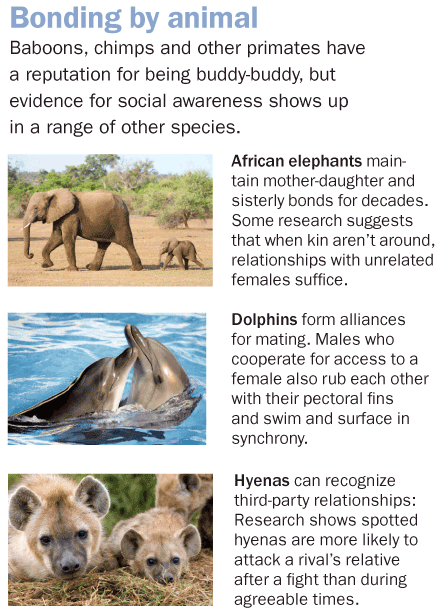 From top: VilliersSteyn/iStockPhoto; Volodymyr Krasyuk/shutterstock; KA Photography KEVM111/shutterstock
From top: VilliersSteyn/iStockPhoto; Volodymyr Krasyuk/shutterstock; KA Photography KEVM111/shutterstock







